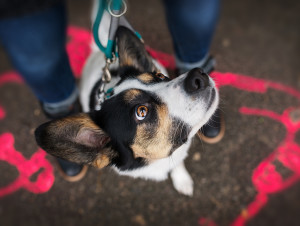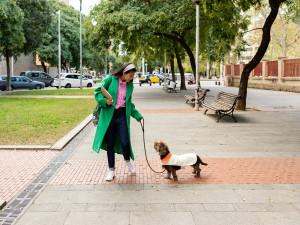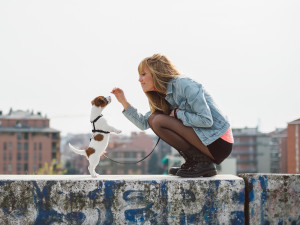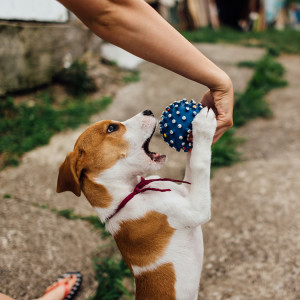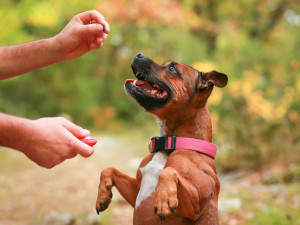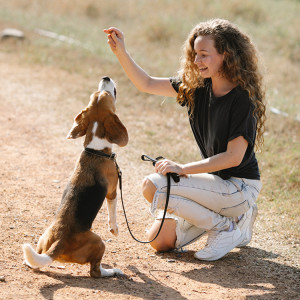These Reinforcement Techniques in Dog Training Will Make Rules Fun For Both of You
Offering fewer treats can actually be a good thing.
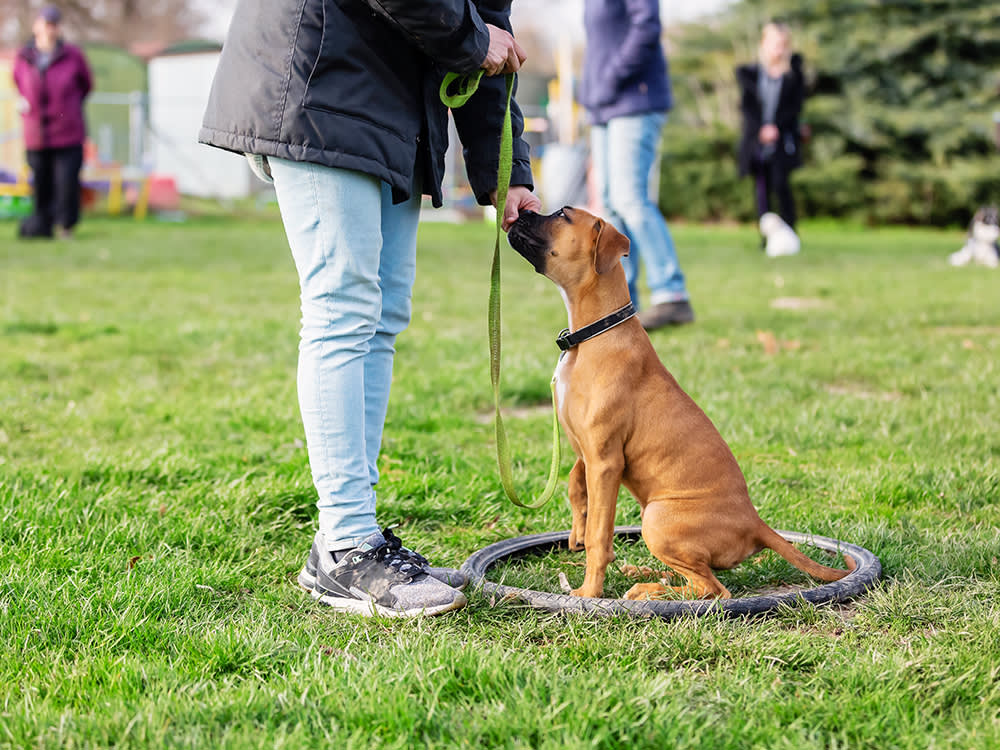
share article

Your pet wants you to read our newsletter. (Then give them a treat.)
Giving a dog a treat as a reward is maybe the only thing most people know about dog training. And who doesn’t like a little treat? But positive-reinforcement dog training, as it’s called, isn’t as simple as that. If you want to teach your dog commandsopens in a new tab, you need to understand reward-based training, so you don’t accidentally slow their progress by giving too many — or too few — treats.
Just imagine you’re in Las Vegas playing a slot machine. Every time you deposit a quarter and pull the arm, you get your one quarter in return. Better than taking a big loss — but pretty boring. Soon, you’d probably lose interest and look for a more surprising machine. But the next machine takes your quarters and never, ever pays out. That would make for one bummer of a Vegas trip, but your bank account would be stoked.
Dogs don’t have bank accounts, but they do experience something like what you just imagined when facing these two extremes: continuous reinforcement — or none at all. That can lead to lower command compliance, or willingness to go along with your rules.
How to Use Positive Reinforcement to Train Your Dog
Teach your dog new cued behaviors and make them more reliable by moving through this reward-frequency hierarchy. Here’s a quick breakdown of how you should use positive-reinforcement dog training — the right way — then dive into the details of how it works.
Initially reward all successful trials to teach the behavior.
Randomly reward successful trials to keep training interesting and improve command compliance.
Become the referee who judges each trial and (randomly) reward only the absolute best performances.
Don’t Over-Treat For Tricks
“My dog will only sit if I have a treat,” mistaken pet parents often say. Over the years, I have heard this refrain many times, and it almost always means the dog was rewarded with treats for sitting on cue too often and for too long. Essentially, the dog had learned two things had to be true for them to comply: the sit cue plus a treatopens in a new tab. If either were not true, they’d find something more interesting to do. Like stand up.
When you begin teaching a new command, try “continuous reinforcement.” For instance, when first teaching a puppy to sit, it makes sense to reward them for every successful completion of the trick or “trial.” Your focus is on pairing the verbal cue and hand gesture with the behavior.
After a while, though, that puppy will stop working so hard. Why bother sitting quickly, or at all, when a treat always comes? Continuous reinforcement will make the dog dependent on the food reward and they will refuse to work unless they get that dang treat. It doesn’t take long to get to that point either, usually just a few days after teaching a new command. That’s why you have to move to a less predictable reinforcement schedule ASAP.
Switch Up Your Reward System
Back to the gambling analogy. Once you’re sure your dog has a grasp on what you’re teaching them, it’s time to become a fair and honest slot machine, dispensing small food rewards less frequently for successful trials.
Side note: get yourself some soft treats that won’t crumble immediately into bits so you can keep them in your pocket.
Slots entice folks to pump coins into machines for hours on end. The psychology behind this phenomenon is that the probability of winning remains constant, even though the number of plays it takes to recoup your money, or better yet, hit the jackpot, changes. The unpredictability makes doing the same mundane activity, over and over, interesting and exciting. You can take advantage of this same psychology to train your dog faster.
When teaching your dog a new command, once you’ve determined that they know what you’re expecting from them, begin randomly rewarding successful trials using “Variable Ratio” positive reinforcement. Start with a low ratio, rewarding roughly one out of every three trials, then increase the ratio over the course of several training sessions.
For example, when teaching your puppy to sit, provide a small treat for successful trials at intervals of 2, 7, 9, 15, 18, 19, 20, 23, and 25. Notice that during 25 trials, sometimes they get three rewards in a row, but sometimes, there’s a longer lag between treats. The idea is to keep them guessing — and working!
Over the course of twice-daily training sessions of two to five minutes each, increase the ratio until they are rewarded for roughly one out of every ten successful trials. The behavior should become a happy habit by then, although, to keep commands fresh, continue to occasionally reward your dog for life. In other words, don’t become the slot machine that never pays a jackpot! And check your pockets for treats before putting them in the laundry.
3. Increase the Reward
There are other types of positive-reinforcement schedules too involved for our purposes here, but one to take advantage of is “differential deinforcement of excellent behavior,” or DRE. This is just a fancy way of saying “better performance earns bigger rewards.” Once you’ve worked through Continuous Reinforcement (treating every time to teach the command) and Variable Ratio (treating randomly to hone the behavior), you can polish the command by handsomely rewarding only the best trials.
DRE is especially useful for things like teaching recallsopens in a new tab. Once your dog is regularly responding to your “comeopens in a new tab” command, and you’ve worked through Variable Ratio reinforcement, start rewarding with higher-value treats, or more of what you have. Only do this when your dog immediately and enthusiastically answers your call. If they stop and smell the roses en-route, no reward is given.
You don’t have to be rigid while going through these steps, as some may be more useful at different times. And if you’re moving too fastopens in a new tab, it’s okay to take a step back. Your dog is not a bad dog because they need lessons to move more slowly.
Jeff Stallings, CPDT-KA
Jeff Stallings, CPDT-KA, who lives in Santa Cruz, Calif., owns Better Nature Dog Training and works with clients throughout the San Francisco Bay Area.
Related articles
![illustration of multi-colored dogs]() opens in a new tab
opens in a new tabIs Your Dog Tricky to Train? Here’s Why You Shouldn’t Feel Guilty
It’s important to remember that dogs are individuals, so training isn’t one-size-fits-all.
![Old Great Dane dog sitting in grass and looking up at the hand of his owner during a training sessions]() opens in a new tab
opens in a new tabAre You Making These Common Dog Training Mistakes?
Pro Karen London, PhD shares the most common dog training errors and how to correct them.
![A dog reaching up to grab a blue ball out of a woman's hand.]() opens in a new tab
opens in a new tabPlaying With Dogs Improves Their Training Success
Post-training play may extend a dog’s memory of previously learned behaviors by up to a year.
![Staffordshire bull terrier and clicker]() opens in a new tab
opens in a new tabWhy Clickers Are The “It” Accessory for Trainers
Pro tips on training your dog with the click of a button — literally.
![Female dog trainer raising a treat above a beagle dog's head]() opens in a new tab
opens in a new tabYour Dog’s Trauma Triggers Are Everywhere. Fear-Free Training Can Help
“America’s Veterinarian” and the founder of Fear Free Pets, Dr. Marty Becker, on how this method makes vet visits, training sessions, and grooming appointments less stressful for pets.
![girl with blue hair starting puppy training with white dog]() opens in a new tab
opens in a new tabPuppy Training 101: How to Train a Puppy
You gotta start somewhere.
